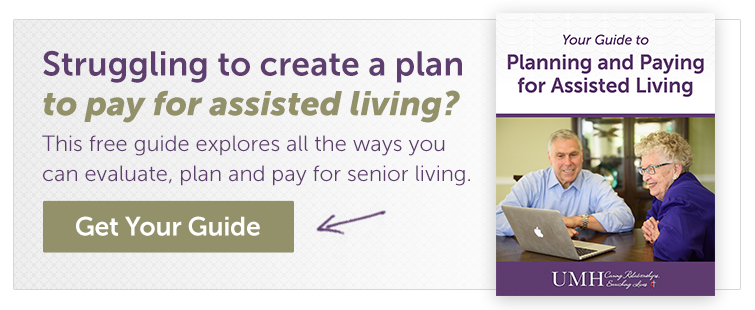How to Find the Best Senior Community for My Budget
Cost is among the biggest concerns for families providing eldercare for a loved one. Indeed, cost can sometimes be a roadblock standing in the way of you providing the best possible situation for a relative in need. While there may be some families out there that are able to cover assisted-living costs without too much of a financial impact, for others, figuring out what to do next will require some serious number crunching.
One of the questions we hear most frequently is "How can I find the best senior living community for my budget?" To help answer this, we have come up with a step-by-step guide to get you started. Follow the recommendations on this page, and you'll begin to have a clearer picture of what assisted-living will actually cost you.
Evaluate Current Care Expenses and Your Budget
This will be your starting reference point, and the easiest way to begin is the old-fashioned way: with pen and paper. Write down all of your monthly expenses and each source of monthly income available to you.
Once you have done that, it is time to specifically zero in on what you are currently paying to care for your loved one. This number will be different for each and every family, but there are some common expenses everyone should look for. Housing, groceries, utilities, medical costs, transportation, indoor and outdoor maintenance, in-home medical or personal care, and adult day care expenses.
Here is another important thing to consider: when making a direct comparison between your loved one’s expenses right now, and the cost of a senior community, remember that many of those expenses will be included in the monthly cost of assisted living. In other words, senior communities may seem expensive, but when you take all of your loved one’s monthly expenses and add them together, you may actually be paying more right now than you would pay for assisted living.
Determine What You Are Looking for in a Senior Community
Each person transitioning into senior living will have their own unique set of requirements, and these may cause large variations in price. In particular, consider the following aspects of assisted living:
How much care is needed? – if your loved one can get around perfectly well on their own, and is simply looking for the convenience and social opportunities of a senior community, your best bet may be to look into more independent living communities where you wouldn’t need to pay for the add-on costs of care and assistance. On the other hand, if your loved one is in need of ‘round-the-clock medical care, they may need to look into assisted living or a nursing home. Each type of community will come with different costs. Another aspect to consider is how much care will your loved one need down the road. Do the communities you’re looking into have increased care options if you end up needing them? It’s up to you to ask the senior living communities these questions and access them internally yourself.
What size apartment is needed? – For many seniors, a one bedroom apartment is popular, while others prefer the simplicity of a studio or efficiency apartment. For instance, if your loved one does not plan to do much cooking, there's no reason to find them a living space with a full kitchen. Studio apartments may seem deterring because they are smaller, but you may find that they’re actually perfect for your loved one. You’ll need to determine how much “stuff” your loved one has and how much room you think they will need to live comfortably. This may save you some money.
Is location important? – Sometimes, there can be significant price variations among different geographic areas. It’s no surprise states like New York, New Jersey, Connecticut and California have higher living costs, but if you live in areas like these, this will be something you’ll need to accept if you want your loved one close to you.If your loved one lives far away and you would rather have them closer to you, begin checking prices in your area, not theirs. Also, don't forget that a few miles can make a huge difference. The senior community in the center of town may be more expensive than one that's a bit further out in the suburbs, but that price difference may be enough to make it affordable for you. Shop around and see what you can find!
Do you need specific amenities? – Most senior communities will offer basic amenities such as meals, social opportunities, and transportation. However, if your loved one would prefer to have access to a health club, a spa, or if they need more medical intervention, you will need to find and price out communities offering those services.
Remember not to sacrifice value for price – You want the best for your loved one. It is very important that the senior community you choose be affordable, but be careful not to take a lower quality of service, safety, or reputation just to save money. There are other things you can look at to cut costs. Trustworthiness isn't one of them.
Need help planning for senior living costs?
Download Our Free Guide "Planning and Paying for Assisted Living"
Know Your Payment Options
You might not have to pay directly out of your personal bank account when it comes to senior living communities. You have a few options to consider, including the following:
Private pay – For the most part, senior communities and assisted-living will be paid for out of private funds. This may include personal savings, retirement plans, or more commonly, money made by selling a home or business.
Long-term care insurance – Some individuals have purchased long-term care insurance plans which are specifically designed to help pay for assisted living costs. Find out if your loved one has such an insurance plan in place, and if so, find out how much coverage has been purchased. This may significantly reduce your out-of-pocket costs.
Social Security benefits – Your loved one may be receiving Social Security benefits either as the result of their age, or if they have become disabled. This money can also help offset costs for caretakers.
Veterans benefits – If your loved one or their spouse served in the military, particularly if they were injured in the line of duty, they may be entitled to assistance with senior community costs. In some cases, these benefits can be quite generous, and can significantly lessen your financial burden.
The purpose of this guide is to get you headed in the right direction when considering senior communities. It is a good starting point, but there is much more detailed information available to you. We also offer a detailed eBook containing helpful steps to make assisted-living more affordable – and the book is available completely free of charge.
To download this in-depth guide, which also includes advice on other payment options available, please click here to receive a copy of Your Guide to Planning and Paying for Assisted Living. You can begin making concrete plans today to get your loved one the best quality of care and attention.
About Chelsea Sayegh
I started working as a Marketing Coordinator for United Methodist Homes in October of 2016. I work on public relations, website management and community planning for their award winning independent and assisted living communities. As a graduate of Ursinus College with a degree in Media and Communications and a passion for serving nonprofits, United Methodist Homes has become my home away from home. I spend my days working in a community filled with smiling faces, helpful hands and wonderful residents. I have a passion for assisting seniors and take great pride in being able to promote a company with such a positive mission and values. As an individual committed to learning and growing, I have jumped right into this exciting career!

Our Blog is a 2016 Platinum Generations Award Winner! The Generations Award is an annual international competition for excellence in senior marketing recognizing professionals who have communicated to the 50+ Mature Markets.





